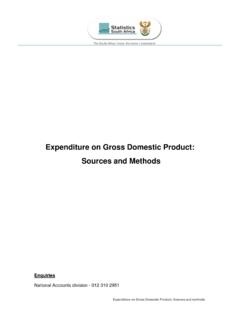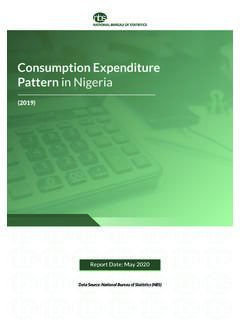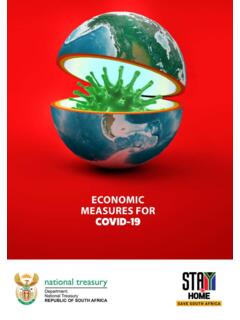Transcription of Gross Domestic Product (GDP) - OECD
1 NATIONAL ACCOUNTS AT A GLANCE OECD 200915 Gross Domestic Product (GDP)1. Size of GDP2. GDP growth3. GDP per capitaGROSS Domestic Product (GDP)NATIONAL ACCOUNTS AT A GLANCE OECD 2009161. Size of GDP1. Size of GDPG ross Domestic Product (GDP) is the standard measureof the value of final goods and services produced by acountry during a period. While GDP is the single mostimportant indicator to capture these economic activi-ties, it is not a good measure of societies well-beingand only a limited measure of people s material livingstandards. The sections and indicators that followbetter address this and other related issues and this isone of the primary purposes of this calculate GDP in their own currencies. Inorder to compare across countries these estimateshave to be converted into a common currency. Oftenthe conversion is made using current exchange ratesbut these can give a misleading comparison of thetrue volumes of final goods and services in GDP.
2 A bet-ter approach is to use purchasing power parities(PPPs). PPPs are currency converters that control fordifferences in the price levels of products betweencountries and so allow an international comparison ofthe volumes of gdp and of the size of economies. ComparabilityAll OECD countries now follow the 1993 System ofNational Accounts, although in some countries, forexample in specific areas such as the own accountproduction of software or financial intermediationservices (indirectly measured) (FISIM), differencesremain, which can impact on comparisons of measurement of the non-observed economy(NOE, often referred to as the informal, grey, shadow,economy) can also have an impact on comparability,although for OECD economies, in general, this is notthought to be significant. (See also Reader s Guide ,relating to PPP based comparisons.)For some countries, the latest year has been estimatedby the Secretariat.
3 Historical data have also been esti-mated for those countries that revise their methodo-logies but only supply revised data for some estimation process mechanically links the newand old series to preserve growth OECD (2009), National Accounts of OECD Countries 2009,Volume I, Main Aggregates, OECD Publishing, database OECD (2009), Aggregate national accounts: grossdomestic Product , OECD National Accounts Statistics(database), reading Lequiller F., N. Ahmad, S. Varjonen, W. Cave Ahn (2003), Report of the OECD Task Force on Soft-ware Measurement in the National Accounts, OECD Pub-lishing, Ahmad N. (2003), Measuring Investment in Software,OECD Publishing, OECD (2002), Measuring the Non-Observed Economy:A Handbook, OECD Publishing, Lequiller F. and D. Blades (2007), UnderstandingNational Accounts, OECD Publishing, OECD (2000), System of National Accounts, 1993 Glossary, OECD Publishing, UN, OECD, IMF, Eurostat (eds.)
4 (1993), System ofNational Accounts 1993, United Nations, Geneva, does Gross Domestic Product mean? Gross signifies that no deduction has beenmade for the depreciation of machinery, build-ings and other capital products used in produc-tion. Domestic means that it is production bythe resident institutional units of the products refer to final goods and services,that is, those that are purchased, imputed orotherwise, as: the final consumption of house-holds, non-profit institutions serving house-holds and government; fixed assets; and exports(minus imports).GDP at market prices can be measured in threedifferent ways: as output less intermediate consumption( added) plus taxes on products (suchas VAT) less subsidies on products; as the income earned from production, equalto the sum of: employee compensation; thegross operating surplus of enterprises andgovernment; the Gross mixed income of unin-corporated enterprises; and net taxes on pro-duction and imports (VAT, payroll tax, importduties, etc.)
5 , less subsidies); or as the expenditure on final goods and ser-vices minus imports: final consumptionexpenditures, Gross capital formation, andexports less Domestic Product (GDP)NATIONAL ACCOUNTS AT A GLANCE OECD 2009171. Size of GDPF igure Domestic Product : current exchange rates and current PPPsThe seven largest economies in the OECD. Percentage of OECD total, 2008 Current exchange ratesCurrent purchasing power parities (PPPs)1 2 2 Gross Domestic Product , current PPPsBillion US dollars199519961997199819992000200120022 00320042005200620072008 Australia3924124374644975255525856226566 97743795830 eAustria18719419920821623023224425226627 5291309316 Belgium228232243248259282292309313323336 354376374 Canada6676917327718258739109389901 0501 1311 2041 2701 303 eCzech Republic13314114314414715416517218419720 8226248257 Denmark120127134139143154158165164175180 190196200 Finland969910811712213313814314415616117 2184188 France1 2041 2431 3021 3691 4251 5331 6301 7111 7011 7681 8691 9612 0812 115 Germany1 8401 8921 9361 9902 0642 1302 2122 2752 3582 4682 5872 7092 8352 928 Greece1561631731791852012182372502672742 94316324 Hungary939710411111512413815015616517118 1189193 Iceland6778889991010111112 Ireland657180899710911813013814816017719 5186 Italy1 2021 2421 2851 3511 3771 4561 5461 5321 5641 5961 6491 7371 8131 849 Japan2 8312 9643 0613 0323 0713 2463 3313 4173 5103 7103 8734 0814 2934 356 eKorea603 e657 e699 e658 e731 e8068609369641 0411 0971 1951 3001
6 358 Luxembourg1617171821232426273032364041 Mexico688 e737 e800 e849 e894 e986 e1 009 e1 048 e1 1081 1861 2941 4021 4851 537 eNetherlands3343523764004264684945165155 41573607644681 New Zealand64677071768085899399103109115115 eNorway103114123122133162167168175194219 243252278 Poland2873113403633834044194424584975265 66614674 Portugal13113714615416417518319119620121 8229242246 Slovak Republic454952565659657073798797108119 Spain6316617017517928579209941 0401 1091 1881 3041 4201 447 Sweden1932002072152292462492592692892923 13335344 Switzerland18919420321021522823424524625 8266290314332 Turkey427 e467 e511 e536518589561572588689781881945998 United Kingdom1 1461 2201 3081 3631 4231 5331 6311 7141 7781 9001 9692 0682 1672 200 United States7 3597 7848 2798 7419 3019 89910 23410 59011 08911 81212 58013 33614 01114 369 Euro area6 1786 3946 6646 9787 2567 7118 1318 4428 6369 0219 48310 04410 64410 910 OECD-Total21 438 e22 541 e23 775 e24 724 e25 914 e27 671 e28 784 e29 879 e30 97732 87834 80537 00439 10340 170 eUnited States33%Other OECD countries26%Spain 4%Italy 5%United Kingdom6%France 7%Japan 11%Germany 8%United States36%Other OECD countries27%Mexico 4%Italy 5%United Kingdom 5%France 5%Japan 11%Germany 7% Gross Domestic Product (GDP)NATIONAL ACCOUNTS AT A GLANCE OECD 2009182.
7 GDP growth2. GDP growthChanges in the size of economies are usually mea-sured by changes in the volume (often referred to asreal) of gdp . Real reflects the fact that changes inGDP due to inflation are removed. This provides ameasure of changes in the volume of production ofan economy. ComparabilityAs described in Section 1, comparability of nominalvalues of gdp across countries is good. There is gene-rally some variability in how countries calculate theirvolume estimates of gdp , particularly in respect ofgovernment consumption, but this doesn t necessa-rily mean that growth rates are less the exception of Mexico, all OECD countriesderive their annual estimates of real GDP using annu-ally chain-linked volume indices (that is the fixedprices/weights are updated every year). Mexico, likemany non-OECD countries, revise their fixed weightsless frequently the last revision occurring after tenyears. Such practices however tend to lead to biasedgrowth rates, usually OECD (2009), National Accounts of OECD Countries 2009,Volume I, Main Aggregates, OECD Publishing, database OECD (2009), Aggregate national accounts: grossdomestic Product , OECD National Accounts Statistics(database), reading Ahmad N.
8 , F. Lequiller, P. Marianna, D. Pilat,P. Schreyer, A. W lfl (2003), Comparing Labour Produc-tivity Growth in the OECD Area: The Role of Measurement,OECD Publishing, Eurostat (2001), Handbook on Price and Volume Mea-sures in National Accounts, Eurostat, Luxembourg. Lequiller, F. and D. Blades (2007), UnderstandingNational Accounts, OECD Publishing, OECD (2000), System of National Accounts, 1993 Glos-sary, OECD Publishing, UN, OECD, IMF, Eurostat (eds.) (1993), System ofNational Accounts 1993, United Nations, Geneva, nominal values of gdp to real valuesrequires a set of detailed price indices, implicitor directly collected. When applied to the nomi-nal value of transactions, the corresponding vo-lume changes can be captured. The detailed vo-lume changes for goods and services typicallyseveral hundred are then aggregated to yieldan overall change in the volume of gdp . In thepast, most countries used fixed weights for thisaggregation and the base year to which weightsrelated was only modified every five to ten is important to recognise that growth rates arenot invariant to the choice of this referenceperiod and measures of growth could turn out tobe biased for reporting years that were remotefrom the base year.
9 Since the 1993 System of National Accounts ithas therefore been recommended that weightsshould be representative of the periods forwhich growth rates are calculated. This meansthat new weights should be introduced everyyear, giving rise to chain-linked (volume) indices(see Comparability, below). Gross Domestic Product (GDP)NATIONAL ACCOUNTS AT A GLANCE OECD 2009192. GDP growthFigure Domestic Product , volumeAverage annual growth rates between 1998 and 20081 2 2 Gross Domestic Product , volumeAnnual growth rates in eCzech e0123456 JapanItalyGermanyDenmarkPortugalSwitzerl andEuro areaBelgiumFranceNorwayAustriaNetherland sUnited KingdomUnited StatesNew ZealandSwedenCanadaMexicoFinlandAustrali aCzech RepublicSpainHungaryTurkeyGreeceKoreaIce landPolandLuxembourgSlovak RepublicIrelandOECD totalGROSS Domestic Product (GDP)NATIONAL ACCOUNTS AT A GLANCE OECD 2009203. GDP per capita3.
10 GDP per capitaGross Domestic Product (GDP) per capita is a core indica-tor of economic performance and commonly used as abroad measure of average living standards or economicwell-being; despite some recognised example average GDP per capita gives no indica-tion of how GDP is distributed between citizens. Ave-rage GDP per capita may rise for example but morepeople may be worse off if income inequalities , in some countries (see Comparability on theright), there may be a significant number of non-resident border or seasonal workers or indeed inflowsand outflows of property income and both pheno-mena imply that the value of production differs fromthe income of residents, thereby over or understatingtheir living full discussion of these issues can be found in theStiglitz-Sen-Fitoussi report (see references).ComparabilityGenerally, particularly because all countries follow the1993 System of National Accounts, the comparability ofpopulation and GDP estimates across countries isgood (see Section 1).


















